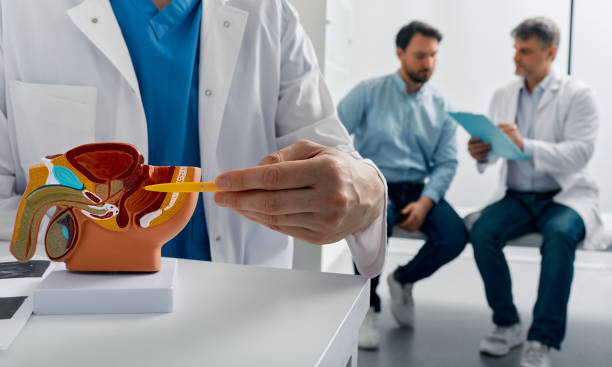Comprehensive Guide to Prostate Cancer: Everything You Need to Know
Prostate cancer is a major health problem for men worldwide, especially in the United States. It is important to understand the different aspects of this disease. We provide a comprehensive understanding of prostate cancer and important information that can help patients and their families cope with this difficult disease.
Prostate cancer is a major health problem for men worldwide, especially in the United States. It is important to understand the different aspects of this disease. We provide a comprehensive understanding of prostate cancer and important information that can help patients and their families cope with this difficult disease.

What is prostate cancer?
Prostate cancer begins in the prostate, a small walnut-shaped gland in a man's body that produces semen. It is one of the most common cancers in men. While some types of prostate cancer grow slowly and may require little or no treatment, other types of prostate cancer are aggressive and can spread quickly.
Symptoms and Diagnosis
Early stage prostate cancer often has no symptoms. As the disease progresses, symptoms such as difficulty urinating, blood in the semen, pelvic discomfort, and erectile dysfunction may develop. Diagnosis usually involves a combination of a prostate-specific antigen (PSA) test, a digital rectal exam (DRE), and a biopsy.
Stages of Prostate Cancer
Prostate cancer is divided into several stages, which helps with prognosis and treatment decisions. The stages range from I to IV:
| Stage I | The cancer is small and confined to the prostate |
| Stage II | The cancer is more advanced, but still confined to the prostate |
| Stage III | The cancer has spread from the prostate to surrounding tissues. |
| Stage IV | The cancer has spread to lymph nodes or other parts of the body (metastasized) |
Treatment options
Treatment of prostate cancer depends on the stage and grade of the cancer, the patient's age, health, and personal preferences. Common treatment options include:
- Active surveillance: Closely monitoring the cancer and choosing treatment if there are signs of something more serious.
- Surgery: Removal of the prostate (prostatectomy) may be a treatment option for localized cancer.
- Radiation therapy: Uses high-energy rays to kill cancer cells. This can be done externally or internally (brachytherapy).
- Hormone therapy: Reduces or blocks the body's production of testosterone, which is needed for prostate cancer cells to grow.
- Chemotherapy: Uses drugs to kill fast-growing cells, including cancer cells.
- Targeted therapy: Drugs or other substances that stop the growth and spread of cancer by affecting specific molecules involved in tumor growth.
Treatment of advanced prostate cancer
If the cancer has spread beyond the prostate (metastasized), treatment aims to control the disease and prolong life, not to cure it. Hormone therapy is often the first-line treatment for advanced prostate cancer. If the cancer continues to grow despite hormone therapy, other treatments may be considered, such as chemotherapy, immunotherapy, or participation in a clinical trial.
Living with Prostate Cancer
For many men, living with prostate cancer has become a long-term journey. Survivors often face many physical and emotional challenges, including coping with the side effects of treatment, dealing with ongoing symptoms, and coping with fears about the future. Support groups, counseling, and recovery programs can play an important role in helping survivors improve their quality of life.
Prostate Cancer Survivor Stories
Survivor stories can provide valuable insight and hope for those currently battling the disease. Many survivors share their stories of diagnosis, treatment, and recovery, and emphasize the importance of regular checkups, second opinions, and information about new treatment options. Their experiences highlight the critical need for support networks and proactive health management.
Prostate Cancer Research and Future Directions
Ongoing research continues to improve the understanding and treatment of prostate cancer. Advances in genetic testing and molecular analysis are paving the way for more personalized treatments. New treatments, such as new medications and advanced radiation techniques, offer hope for better outcomes and fewer side effects.
Q&A
Q: What are the risk factors for developing prostate cancer?
A: Risk factors include age (most common in men over 50), family history, race (most common in African American men), and certain genetic changes.
Q: Can prostate cancer be prevented?
A: While there is no sure way to prevent prostate cancer, a healthy diet, regular exercise, and routine checkups can reduce your risk.
Q: What is the survival rate for prostate cancer?
A: Survival rates vary depending on the stage at diagnosis. Early-stage prostate cancer has a higher survival rate, while late-stage cancer has a lower survival rate.
Q: What are the side effects of prostate cancer treatment?
A: Side effects may include urinary incontinence, erectile dysfunction, fatigue, bowel problems, and emotional distress.
Q: Are there new treatments for prostate cancer?
A: Yes, ongoing research is continually developing new treatments, including more effective drugs. Advanced radiation therapy and immunotherapy.